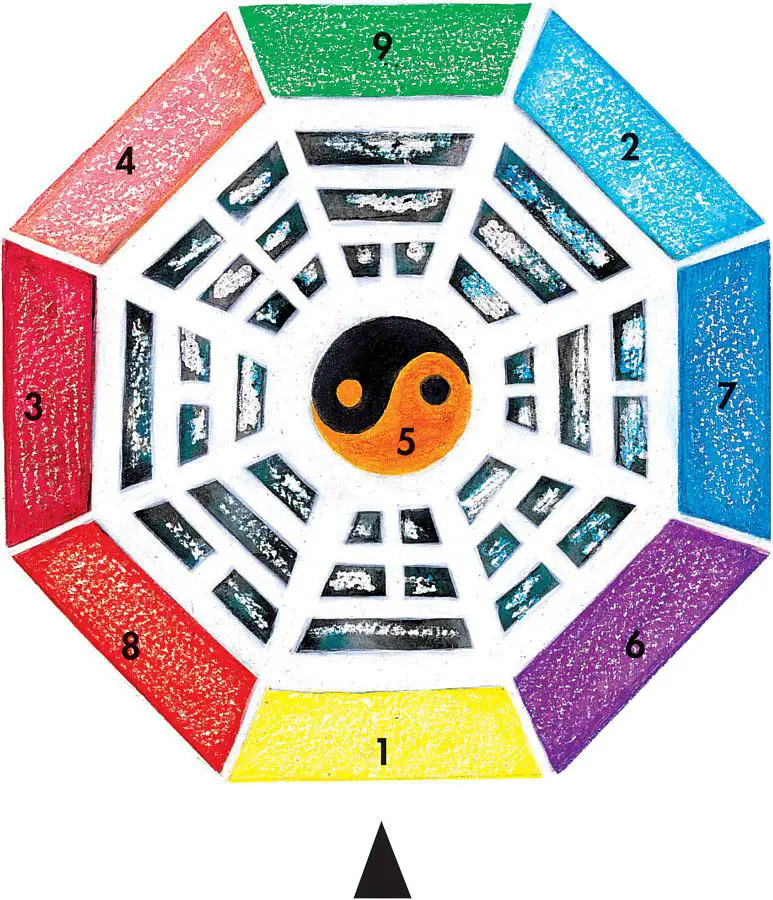Have you ever heard about Feng Shui? This is a millenary discipline and art created, studied, and developed by the astonishing Chinese civilization. It focuses on improving indoor or outdoor designs, architectural spaces, the environment, and any place that involves human contact with nature. In this instance, we’ll talk about Feng Shui.
This type of garden is characterized by conveying a sense of relaxation and harmony. It can be made in different sizes and for both inside and outside spaces. Would you like to learn more about Feng Shui gardens? If so, this blog is for you.
Here, we’ll explain the meaning of this beautiful garden, its general principles, what to take into account for its creation, how to arrange the vegetation, what elements you can use to bring harmony to the garden, and what species of plants are suitable for it.
Table of Contents
What does a Feng Shui garden consist of?
The concept of Feng Shui means wind and water and aims to establish a relationship with nature and the environment that allows humankind to achieve stability, mostly energetical. Just in case you were wondering, this garden is also known as a Zen garden.
For this reason, Feng Shui has certain principles that form a large number of combinations, mixes, and associations between nature and architectonic structures surrounding people.
These principles are the Ch’i, the Yin, and Yang, and the 5 elements. Below, I’ll explain what each one consists of.
The Ch’i
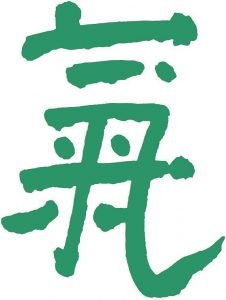
This concept refers to the vital energy, or, what we call, the soul. It’s characterized by depicting the strength of each individual’s inner energy, and how the correct distribution of this energy enables the life of people and nature.
When Ch’i is lost or stagnated, it has a negative influence on people’s health and plans. It can be the case, for example, when we feel that things are not working out the way we want, or when we have economic, sentimental, or work problems, and so on.
Yin and Yang

The Yin embodies the feminine principle, as well as the night, the cold, the moon, the darkness, the north, and the passive. The Yang is the opposite principle of Yin: the masculine, the day, the south, the heat, the light, the sun, and the active.
This principle arises from the Tao, which refers to the whole, to the absolute, and are forces that complement and oppose each other. When in harmony, they are interdependent and don’t cause any conflict. Everything that surrounds us, including people, is generated from this principle.
The 5 elements
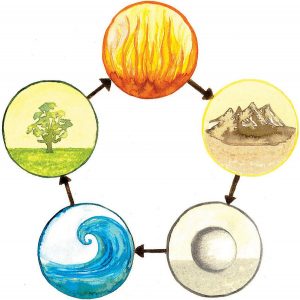
In Feng Shui, there are 5 elements that constitute life: fire, earth, wood, water, and metal. Each of them has a definition that helps to understand why they are important to this practice.
- Fire stands for the South, the heat, the energy, and the force.
- Earth stands for the Center, family, and stability.
- Wood stands for the East, future, creativity, and growth.
- Water stands for the North, introversion, communication, and movement.
- Metal stands for the West, competition, hardness, and instability.
As you could notice, each element has a cardinal point as a guide. That’s because you can combine the characteristics of the elements with cardinal points in order to integrate and create balanced environments.
The Ba Gua
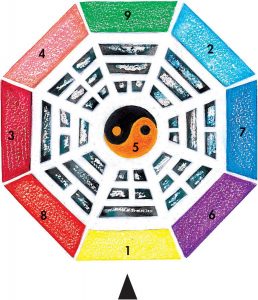
Ba means eight and Gua means trigram. This is one of the instruments used in Feng Shui and resembles a sort of octagonal compass. With it, you can identify the main areas of a space, such as your home or office, and the relationship with several aspects of your life.
It’s divided into 9 sections that correspond to the directions of a common compass (north, northeast, northwest, east, southeast, south, southwest, west) and the center point. Each sector has a name related to a specific area and element.
- K’an is related to profession and water.
- K’un is associated to relationships and earth.
- Chen is related to family and thunder.
- Sun is related to wealth and wind.
- Tai Ch’i is related to health.
- Ch’ien is related to benefactors (friendship) and heaven
- Tui is related to creativity and the lake.
- Ken is related to knowledge and the mountain.
- Li. is related to fame (success) and fire.
Aspects to consider for the creation of a Feng Shui garden
When you decide to create a Feng Shui garden is for you want to have a space with harmony, tranquility, and enriching energy for the place and for you. This type of garden can be very diverse since it is possible to have different elements, but it’s important not to overdo it, especially regarding plants.
Keep in mind that the vegetal elements that you use should be in perfect condition and, if this isn’t the case, it’s best to replace them. Plants can be sown within a prudent distance from each other so that they can develop properly. You can choose plants of different sizes, species, colors, and characteristics.
Besides, you can create pathways, preferably curvilinear, so as to enable visitors to wander through the garden and enjoy its beauty.
It’s worth including resting areas to sit in, a fountain or a fish pond, parterres, and others. Everything will depend on the space you have and whatever suits your needs.
This type of garden can include:
- Viewing in motion: requiring large spaces whose landscape can change thanks to the pathways made up of different elements (fountains, ponds, parterres, embroideries, etc.).
- Stationary viewing: they have small dimensions; their elements can be seen from a fixed point since the details can be better appreciated in this way.
Terrain morphology
Choosing the land where you’ll place your Feng Shui garden is essential because you must know its characteristics and the energetic and vegetal resources available.
This way it’ll be much easier to have a guide for starting your garden. Besides, you can add elements that you think are missing to complete the composition of the garden.
When adding the absent elements to the land, it’s imperative to balance them in the space and create a harmonious coexistence. Keep in mind the environment or context around the garden, whether it is placed in the city, a mountain, the countryside, or any other place. By understanding the surroundings, you’ll be able to choose easily the vegetation, the elements, colors, and other aspects.
Also, climate conditions must be considered, as they would influence the selection of plants and elements to be used.
Remember that plants have their own requirements regarding the environmental conditions to which they will be exposed. For example, there are those that can withstand direct sunlight, others that like semi-shade or shade, and others that like low humidity environments, as well as a series of specifications that we have already mentioned in other specialized blogs.
Do not forget that knowing the terrain and its conditions is crucial to maintaining the status quo. Remember that Feng Shui is based on the balance of elements and spaces.
Domestic garden
According to Chinese principles, gardens found in a house should be considered an extension of it. It can be seen as the outside continuation of a home or domestic space where people can enjoy contact with nature.
Thus, it would be advisable to use elements that reflect the home’s spirit and the soul of its inhabitants. Also, you should take care of this space in the same way as you take care of your home, as it is part of it.
The design of your home’s Feng Shui garden should not necessarily be symmetrical or have rigid lines. It’s better to pursue a casual and relaxed distribution because, in this way, the Ch’i can flow better.
There is no need to overload the garden with plants or decorative elements, just a few that integrate in the best way. The goal is that your garden grows along with you so that you can witness a life’s development, and experience the moments of wait and death.
Tips for creating a domestic Feng Shui garden
Avoid placing large trees near the home’s windows, this way the house isn’t suffocated and the Ch’i can circulate from the inside to the outside and back again.
- The garden entrance can have winding access, that is, with curves, bends or undulations.
- Around the pathway, you can have a few plants of various characteristics and sizes.
- You can place the tallest plants on the edges of the house to protect it from external elements without disturbing the flow of energy.
- You can arrange the flowers, plants, and rocks chromatically. Besides, you may choose plants whose flowering occurs at different times of the year.
- It’s nice to mess around with different elements such as parterres, sitting benches, fountains, birdbaths, ponds, small flowery hills and so on. So don’t hesitate in using them, of course, not in excess.
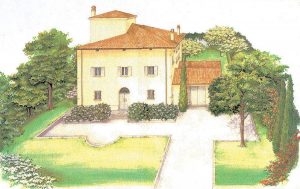
Public Feng Shui garden
For the type of Feng Shui garden to be effective in public spaces, it should be matched to the current conditions of the space.
For example, if the garden is intended for children, it should have open, safe areas with soft shapes and free of elements that may represent some kind of danger.
Trees, if added, should be large and sturdy to provide a sense of safety and allow playing and climbing. Plants can be small, avoiding delicate flowers and poisonous leaves. As you may know, some plants are very toxic for children and pets.
For gardens meant to be close to study environments, like libraries, universities, museums, and others, we recommend adding grass, different species of plants, and furniture such as a bench. Ponds can also be included as water promotes concentration.
A Feng Shui garden thought for the elderly should have an accessible, well-kept, flat terrain, with rugged paths and no crevices. It should have benches, tables, kiosks, or areas to shelter from the weather; and a variety of plant species to convey a feeling of hospitality and serenity.
In large public spaces, the garden can be divided into differentiated areas with distinctive elements. Optionally, you can build bridges over the water, spaces for resting and eating, a space for animals, and a space for a vegetable garden or nursery.
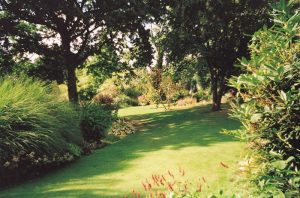
Garden of representation
These gardens are used in public buildings or private farms, yet they require to be integrated more strongly with the surrounding structures. Sometimes the mistake of turning this space into an unpleasant ambiance is made as there is no connection with the existing buildings.
You can use large, imposing trees and eye-catching plants with soft and attractive shapes. In this way, visitors will focus their attention on the beauty of the plants and feel a sensation of pleasure and harmony.
Although sometimes it’s not possible to modify the rectilinear structure of the pathways in the terrain, it is possible to add decorative elements. These can be statues, fountains, or parterres that help to reduce a little the symmetrical view of the area, aiding Ch’i’s mobility.
Sometimes they’re very restricted spaces, so you can use plants that highlight the importance of the place. In this way, the visitor will be able to perceive the surrounding energies of the edification.
How to arrange the greenery in the Feng Shui garden?
At home, a Feng Shui garden can be placed in any available space; however, plants should be present in it. Plants are essential to fulfill the Feng Shui concept and also bring great benefits to the environment and other living beings.
Next, I’ll talk about some of the spaces where you can have plants for the Feng Shui garden.
Green Corner
This space is located inside the house and is ideal for those who don’t own a large outdoor area. They are decorative spaces that help increase Ch’i inside the home, as well as purify the environment.
For this space, above all, it’s advisable to use plants that are already adapted to indoor living. Although it’s fine to have outdoor plants inside, most times, it’s done only to protect them from a harsh season, such as winter, rather than to create a green corner.
Also, it’s advisable to maintain a temperature of about 20 °C (68 °F), proper humidity according to the plant species, and avoid artificial heat sources. Remember, you must be familiar with the plant’s requirements, because you must control sunlight, watering, substrate, pruning, and fertilizing, among other aspects.
You can place your green corner in any of the following areas of your home:
- Living room: place the plants about 1 or 2 meters away from the window to avoid drafts.
- Dining room: place the plants in spaces with good lighting but that doesn’t interfere with the passage.
- Hallway: use plants that can withstand shade since this is usually an area with very little illumination.
- Kitchen: in this space, you can unleash to grow aromatic plants on a flat surface and under the window.
- Study: here, use plants that help purify the air and absorb electromagnetic waves from computers and other electrical devices.
- Bathroom: for this space, we recommend plants that absorb humidity and create a relaxing atmosphere, like a bonsai.
- Bedroom: you can place the plants a little away from the bed or near the window, in our blog about bedroom plants you can find more information.
Terrace and balcony
Green spaces in these areas will work as a filter between outside and inside. However, some of the plants could be affected by sudden seasonal changes.
Hedges and trellises with climbing plants are therefore recommended. Do not omit to have clear the requirements of each plant so that they can have an optimal development and duration.
You need to take into account the balcony or terrace orientation because depending on this, you’ll have to take more or less care regarding sunlight (to the South, West, North, or East). In addition, you can supply water through an irrigation system that prevents waste.
Avoid planting more than 2 or 3 species of plants in the same pot and make sure that they have equal substrate requirements. Otherwise, they could be harmed and suffer from disease or die.
Besides combining plants, pots can also be combined in different sizes, for example, to make your terrace or balcony look even more charming and to create that Feng Shui characteristic harmony.
If you have enough space, you can include a table, a sun umbrella or even a hammock.

Vegetable gardens
You can also have vegetable gardens in your Feng Shui garden, as long as you place them in a sunny and sheltered spot. The vegetable garden should be in equilibrium with the rest of the ornamental plants, but in a more natural setting.
The best is to plant foods that you do use in the kitchen, that are easy to cultivate, and that grow fast. In addition, inform yourself about which plants can be planted together and which cannot, so you can avoid interferences.
Here is a list of some vegetables and legumes that you can grow in this garden. You can also plant some fruits and fruit trees.
- Eggplant
- Zucchini
- Onion
- Beans
- Lettuce
- Lentil
- Potato
- Tomato
- Carrot
Elements to bring harmony to the Feng Shui garden
As I mentioned before, there are several elements that you can include in your Feng Shui garden that will contribute to generate that harmony and balance we’ve been talking of. These are some of the elements that you can have in your relaxation space.
Parterres
This is a separate section of the garden consisting of plants or flowers. You can place them near the house entrance, where they’ll be visible, yet not close enough to interrupt the passage of people.
Use rocks for the edges of the parterres to give the impression of a smooth and irregular contour. You can grow plants that bloom at different times of the year, such as myosotis, primroses, and cyclamen.
You can also position your flowerbed based on the garden orientation, contributing to the activation of the 5 elements’ forces.
- South: here we recommend Mediterranean, tropical or desert plants that can withstand the sun.
- East: you can have woody plants with more of a leafy-green nature than flowering ones.
- North: in this location you can have perennials and small fountains.
- West: old, hardy, long-lived, and low light-requiring plants are recommended.
- Center: you can have a nice green lawn or some simple, well-kept flowering plants.

Pathways
The paths or walkways of your Feng Shui garden can be made of small stones, gravel, or stone slabs. We recommend a winding and sinuous shape, and remember that symmetry is not much used in Feng Shui.
Such patterns help to distribute the Ch’i less violently from the house interior to the exterior and vice versa. If, for example, the paths are established with no possibility of modifying them, you can place small bridges, fountains, water troughs, and other elements.
Along the edges and paths, you can plant small flowering plants that will accompany you during your walk, even a short one. This way, you can have a great experience in your Feng Shui garden.
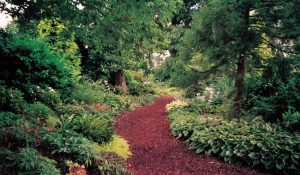
Stones
Stones and minerals, in general terms, are characterized by having their own very particular vibration. This allows them to act as energy generators and transmitters of frequencies to the environment.
For Feng Shui gardens, sand, gravel, and stones are important, in balance with the plants. You can choose hard stones or colored stones from mountains or rivers with different characteristics. Everything will depend on available space and the harmony and balance you seek for the garden.
Example of stones in the garden
Statues
These pieces can create a spiritual interaction the place in which the garden is located and with the people around it. Therefore, you need to choose them wisely.
These are some statues that you can use:
- Religious statues: to convey feelings of well-being and positivism; these can be light and not too bulky.
- Animal statues: they release an energetic and symbolic charge depending on the animal represented.
- Fantastic statues: analyze their meaning according to their origin in order to avoid negative energies.
- Abstract statues: the shapes, colors, and materials of these elements are highly valued due to the principles of Feng Shui.
Make sure that the statue you are going to use is well preserved. You can place it next to the entrance door or under a kiosk or resting area as long as they match the rest of the furnishing in your garden.
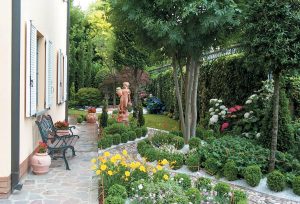
Containers for plants
These containers help to increase the functionality and comfort of the garden, and because of their shape, color, and material, they may activate some of the elements of Feng Shui. When they contain plants, the energies present in them are increased.
You can use plastic, terracotta, wood, or cement containers; it all depends on the needs of the plants and what you want for your garden. Remember that plants require a little more attention when in pots; it’s not their natural environment.
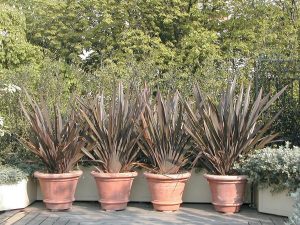
Shed or tool cabinets
These structures are great allies for the Feng Shui garden as they allow you to properly organize your tools and avoid wasting time and money. In our blog on tool cabinets, we detail their benefits and how you can build one.
Be sure to provide your cabinet or shed with good lighting, ventilation so that some products don’t spoil, and proper hygiene. The more shelves you have, the easier it will be to organize your tools and find them.
Space for animals
Animals transmit great energy and vitality, and that’s why it’s convenient to grant some space for them in the garden. This way our pets can coexist with it, be part of our lives and protect us from unwanted visits.
Do not forget to leave ample space for them to walk, run and play freely. Our friends also deserve a space of relaxation and distraction; it’s not superfluous to give them one. You may even attract other animals, such as birds, with the help of fountains or drinking troughs.
Water
Water, vital for everyone, is, naturally, a fundamental element of Feng Shui; no life would occur on the planet without it. This resource shapes natural forms, brings vital energy, muffles noises, and smooths rough places.
Moving water such as that found in rivers, streams, waterfalls, fountains, ponds, etc., is always valuable. Avoid motionless water, as it generates the occurrence of negative energies.
The movement should be well balanced, neither too abrupt nor too quiet. In addition, it’s better if it doesn’t flow on straight lines or overflow the shores. You can place the elements containing water in the vicinity of your house or the building housing the Feng Shui garden.
Example of a water fountain
Natural light
Natural light, i.e. sunlight, is also one of the essential Feng Shui elements; its warmth makes life on earth possible. Besides, it’s a pleasure to enjoy such natural lighting, of course, always taking proper precautions.
Every living being’s organism requires exposure to natural light for at least a few hours a day in order to function properly. This element helps to improve mood and provides joyful feelings.
You can place the areas for resting and relaxation to the east of the garden so that you can receive the most favorable rays, yet don’t forget to protect your skin from the sun. Avoid having very tall plants in that space so that they don’t obstruct the passage of light and Ch’i.
Allow sunlight to enter your home, don’t install too dark curtains or leafy plants near the windows. Use only a veil to screen some of the light during the most intense day hours.

Artificial light
You may also use devices that provide artificial light and serve to enhance balance in your Feng Shui garden. Tall street lamps, ground lighting for pathways, and lamps for the house entrance will work perfectly.
Hide the lights’ wires so that they don’t upset the balance of the garden and the other elements. Use energy-efficient lamps and place switches inside and outside the house to dim the lights.
These artificial lights will help you highlight whatever you want to emphasize most in your Feng Shui garden, so install them strategically. You can leave the lights on for at least 3 hours every night as this will activate the Ch’i if it is a little weak in some areas.
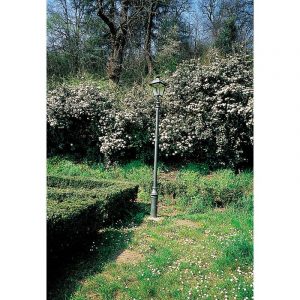
Species of plants suitable for Feng Shui garden
As you already know, there are endless plant varieties that you can have in your Feng Shui garden that will provide everything you need to comply with the principles of this practice. These are some plant genera that you can plant in your Zen garden:
Flowers
Flowering plants are perfect for activating Ch’i because they join the strength of the leaves green, the color of their flowers, and the scent of their inflorescences. Don’t forget to choose the flowers having in mind the combinations they’ll make when in bloom.
Try to leave some space between the plants; in these empty intervals, you can integrate other elements, such as artificial lights.
Here is a list of the species you can use:
- Camellia – Camellia spp
- Chrysanthemum – Chrysanthemum spp.
- Cyclamen – Cyclamen spp
- Poinsettia – Euphorbia pulcherrima
- Gardenia – Gardenia spp
- Hydrangea hydrangea – Hydrangea hortensia
Shrubs and herbaceous plants
With this genus of plants, you can create hedges and colorful spots as they grow as covering and robust plants. There is a great variety of evergreen shrub species that can be found in gardens easily.
What you should try is to associate them with other species of plants, always leaving a prudent distance, as they can become a bit invasive. Here are some species that will work for you:
- Burdock – Arctium lappa
- Arnica – Arnica montana
- Bamboo – Arundinaria spp
- Aloe vera – Barbadensis miller
- Calendula – Calendula officinalis
- Lemon balm – Cymbopogon nardus
Climbing plants
These plants tend to twine and elongate around some kind of support, which can be wood, one of the 5 elements of Feng Shui. These plants can decorate unappealing structures in your garden and give them a nice new look.
You should use containers with large capacity so that the plants can develop properly. These are some of the climbing species that can be planted in Feng Shui gardens:
- Bougainvillea – Bougainvillea spectabilis
- Clematis – Clematis spp.
- Ivy – Hedera spp
- Jasmine – Jasminum spp
- Passionflower – Passiflora spp
- Wisteria – Wistaria sinensis
Trees for Feng Shui
These marvelous creatures create well-being and harmony in any type of garden, so they cannot be missed. Trees function as a reference point, generate a microsystem, rebalance vital functions, and absorb pollutants. Also, as is mentioned in the book The Feng Shui Garden, “they protect the houses of the living and guard the souls of the dead”.
They are fundamental to keeping the surrounding Ch’ in balance. The greener they are, the more vital energy they produce. These are some of the species of trees you can have in your garden:
- Horse chestnut – Aesculus hippocastanum.
- Bitter orange – Citrus aurantium
- Citrus bergamia – Citrus bergamia
- Cyprus – Cupressus sempervirens
- Magnolia – Magnolia spp
- Olive tree – Olea europaea Sativa
Aromatic plants
These plants can be found in various places and will be useful in case you want to have an herb garden in your Feng Shui. They have several properties that will help you both with culinary and medicinal purposes. These are some species:
- Garlic – Allium sativum
- Cinnamon – Cinnamomum zeylanicum
- Coriander – Coriandrum sativum
- Clove – Eugenia caryophyllata
- Bay laurel – Laurus nobilis
- Peppermint – Mentha piperita
Plants against pollution
These plants will work to combat the pollution that is found in large cities and that affects air quality. You can place them in strategic places of your home to work as purifying plants.
They are beautiful, resistant and require little care. These are some of their species:
- Papyrus – Cyperus papyrus
- Ferns
- Ficus – Ficus benjamina
- Mistletoe – Viscum album
- Tillandsia – Tillandsia spp.
- Spathiphyllum spp – Spathiphyllum spp
Note: On our site you can find other blogs that give you information about different types of gardens. I am sure you ‘ll fall in love with all the types of gardens we recommend:
______________________________________________
The Feng Shui practice will help you to maintain a balance between you and your environment; the best thing is that you can use it to create a spectacular garden. There you can have a space to share with others, reflect, rest, think, and do everything you need to carry a harmonious life.
Do not miss the opportunity to have the garden of your dreams. I’m sure you won’t regret having a Feng Shui garden wherever you want. Go for it!
